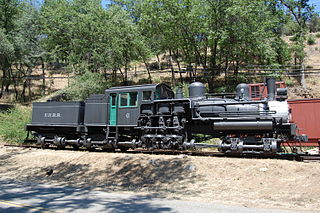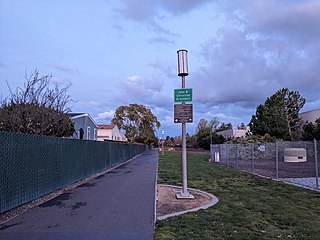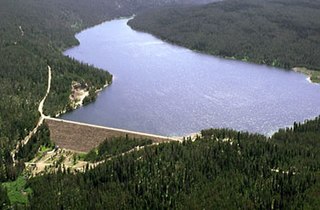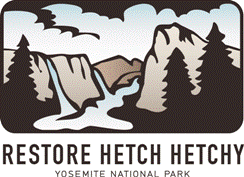
A railcar is a self-propelled railway vehicle designed to transport passengers. The term "railcar" is usually used in reference to a train consisting of a single coach, with a driver's cab at one or both ends. Some railway companies, such as the Great Western, termed such vehicles "railmotors".

Hetch Hetchy is a valley, a reservoir, and a water system in California in the United States. The glacial Hetch Hetchy Valley lies in the northwestern part of Yosemite National Park and is drained by the Tuolumne River. For thousands of years before the arrival of settlers from the United States in the 1850s, the valley was inhabited by Native Americans who practiced subsistence hunting-gathering. During the late 19th century, the valley was renowned for its natural beauty – often compared to that of Yosemite Valley – but also targeted for the development of water supply for irrigation and municipal interests. The controversy over damming Hetch Hetchy became mired in the political issues of the day. The law authorizing the dam passed Congress on December 7, 1913. In 1923, the O'Shaughnessy Dam was completed on the Tuolumne River, flooding the entire valley under the Hetch Hetchy Reservoir. The dam and reservoir are the centerpiece of the Hetch Hetchy Project, which in 1934 began to deliver water 167 miles (269 km) west to San Francisco and its client municipalities in the greater San Francisco Bay Area.

The Tuolumne River flows for 149 miles (240 km) through Central California, from the high Sierra Nevada to join the San Joaquin River in the Central Valley. Originating at over 8,000 feet (2,400 m) above sea level in Yosemite National Park, the Tuolumne drains a rugged watershed of 1,958 square miles (5,070 km2), carving a series of canyons through the western slope of the Sierra. While the upper Tuolumne is a fast-flowing mountain stream, the lower river crosses a broad, fertile and extensively cultivated alluvial plain. Like most other central California rivers, the Tuolumne is dammed multiple times for irrigation and the generation of hydroelectricity.

The Hetch Hetchy to Lake Vernon Trail in Yosemite starts from the parking lot close to the O'Shaughnessy Dam at the Hetch Hetchy Reservoir, and goes to Lake Vernon through the Yosemite Wilderness. Staying overnight requires a wilderness permit which can be obtained at the Hetch Hetchy ranger station or reserved online.

The John Muir National Historic Site is located in the San Francisco Bay Area, in Martinez, Contra Costa County, California. It preserves the 14-room Italianate Victorian mansion where the naturalist and writer John Muir lived, as well as a nearby 325-acre tract of native oak woodlands and grasslands historically owned by the Muir family. The main site is on the edge of town, in the shadow of State Route 4, also known as the "John Muir Parkway."

The Raker Act was an act of the United States Congress that permitted building of the O'Shaughnessy Dam and flooding of Hetch Hetchy Valley in Yosemite National Park, California. It is named for John E. Raker, its chief sponsor. The Act, passed by Congress in 1913 by the Wilson administration, specified that because the source of the water and power was on public land, no private profit could be derived from the development. The plan for damming the valley was fought for years by John Muir. Construction of the dam was finished in 1923.

Moccasin, an unincorporated community in Tuolumne County, California, is located at the intersection of State Route 49 and State Route 120. The community is sited on the shore of Moccasin Reservoir at the edge of Lake Don Pedro. The town is home to a State of California Resources Agency, Department of Fish and Game fish hatchery.

Wapama Falls is the larger of two waterfalls located on the northern wall of Hetch Hetchy Valley below Hetch Hetchy Dome, in Yosemite National Park. It flows almost year-round and during peak flow has been known to inundate the trail bridge crossing its base, making the falls impossible to pass. The falls consist of two primary drops angled roughly 60 degrees to each other, and a broad cascade at its base.

Cherry Lake is an artificial lake in the Stanislaus National Forest of Tuolumne County, California, U.S.A., about 25 miles (40 km) east of the city of Sonora. It is at an elevation of 4,700 feet (1,433 m) on the western side of the Sierra Nevada, and lies just outside the western boundary of Yosemite National Park. The lake has a capacity of 273,500 acre⋅ft (337,400,000 m3) and is formed by Cherry Valley Dam on Cherry Creek.
The Hetch Hetchy Railroad (HHRR) was a 68-mile (109 km) standard gauge Class III railroad constructed by the City of San Francisco to support the construction and expansion of the O'Shaughnessy Dam across Hetch Hetchy Valley.

The Parsons Memorial Lodge is a small building built in 1915 by the Sierra Club at the northern end of Tuolumne Meadows in Yosemite National Park. It was one of the earliest structures built of stone in a national park.
The Hotel Charlotte, also known as Hotel Charlotte & Cafe or Hotel Charlotte & Restaurant, is a hotel opened in 1921 in Groveland, California. It was listed on the National Register of Historic Places in 1994.

Falls Creek, also known as the Falls River, is a tributary of the Tuolumne River in Yosemite National Park, California, United States. The creek begins at the northern boundary of the national park and flows 24 miles (39 km) to empty into the Tuolumne at Hetch Hetchy Reservoir, dropping over two well-known waterfalls. The Pacific Crest Trail and other national park trails follow the creek for much of its course.

Hetch Hetchy Railroad no. 6 is a standard gauge three truck Shay locomotive built for the Hetch Hetchy Railroad by Lima Locomotive Works in 1921.

The John W. Christian Greenbelt is a stretch of green land in northern Sunnyvale, California.

Grassy Lake Dam is a small dam operated by the U.S. Bureau of Reclamation in Teton County, Wyoming, immediately to the south of Yellowstone National Park. The dam lies in a corridor of Caribou-Targhee National Forest that runs between Yellowstone and Grand Teton National Parks. The dam structure and outlets are within a few hundred feet of the south boundary of Yellowstone. The zoned earthfill dam was built between 1937 and 1939 as part of the Minidoka Project, which provides water to irrigate farmland in Idaho's Snake River Plain.

Restore Hetch Hetchy is a US non-profit organization seeking to restore the Hetch Hetchy Valley in Yosemite National Park to its original condition.

O'Shaughnessy Dam is a 430-foot (131 m) high concrete arch-gravity dam in Tuolumne County, California, United States. It impounds the Tuolumne River, forming the Hetch Hetchy Reservoir at the lower end of Hetch Hetchy Valley in Yosemite National Park, about 160 miles (260 km) east of San Francisco. The dam and reservoir are the source for the Hetch Hetchy Aqueduct, which provides water for over two million people in San Francisco and other municipalities of the west Bay Area. The dam is named for engineer Michael O'Shaughnessy, who oversaw its construction.
Moccasin Dam is a small dam on Moccasin Creek in Tuolumne County, California, in the town of Moccasin, west of Yosemite. It holds the Moccasin Reservoir. The dam, reservoir and associated hydroelectric power plant are part of the Hetch Hetchy Project, which provide water and power to the city of San Francisco. The dam is located near the junction of Highway 120 and Highway 49.

Hetch Hetchy Dome is a granite dome, in the Hetch Hetchy area of Yosemite National Park.


















